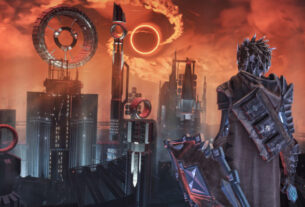
Bend to your will
Semblance is a game that relies on your enjoyment of the satisfying feeling that comes with the act of reshaping objects and environments. The game’s world and its unnamed blobby protagonist are as malleable as playdough, and it’s up to you to restore this world after it is infected by another harder, sharper race of blob. It’s thin on plot justification, but that’s fine–Semblance is a solid puzzle-platformer with a great hook and well-designed levels.
The game has you solve level-manipulation puzzles to collect numerous scattered orbs floating just outside of your reach. When you come across an orb, the camera will zoom out so that every piece of the landscape you need to solve the puzzle fits within a single screen, and it’s up to you to figure out which platforms and walls to bend and shape to reach the orb. Levels are decorated using limited color palettes, but if a platform or wall has one consistent color tone, you can squish and deform it with your body.
Your character, a small indistinct blob, can move, jump, dash, and “reset” shifted pieces of the environment. Dashing allows you to shift or reshape platforms and dig crevices into larger parts of the level. You might need to dash into a suspended platform from below to push it up, creating a hump you can use to reach a higher ledge; alternatively, you might need to dash into the ground to create a hole so that a dangerous object moving on a set path through the level will pass over the top of you. At several points you can wall-jump by dashing into the platforms around you, creating little crevices to move between. It’s all about finding ways to bend the environment into the shape you need it, with some mild platforming elements thrown in.
The puzzles in the game get much more complex over time with the addition of new obstacles and mechanics. In later levels, you’re able to squash yourself flat, horizontally or vertically, which allows you to jump higher or further (like you’re a frisbee being thrown around) and fit through narrow gaps, which leads to some great puzzle designs but also highlights the game’s slightly fiddly controls. The blob’s inertia is hard to come to grips with, and it’s a little harder to move sideways in the air than it is in most platformers. It’s easy to dash in the wrong direction during a jump, and on a few occasions, a platforming section seemingly became more difficult than necessary, because during a dash I’d deformed the platform I was meant to land on. Thankfully there’s an option to reset the screen, but this can mean repeating a lot of steps during the more complicated puzzles.

Semblance is often frustrating, but solving a puzzle, and figuring out which step you’ve been missing in your process, can be very rewarding. Mid-way through the game you’ll start to encounter lights that can snap objects back to their original form if they touch them. These lights are used for several clever puzzles; for example, you might need to press a platform down so that it touches a light below you, causing you to shoot into the air when the platform springs back into its original shape like you’ve just jumped on a trampoline. The game finds lots of inventive ways to deploy this trick throughout the game. There are a few moments where puzzle solutions are immediately obvious, or ideas get reused, but most screens require lateral thinking from the player. Insta-kill laser beams and fields that block your dash ability are also used to clever effect throughout.
Semblance is a charming experience, with a cute protagonist and nice sense of visual style, even if it never quite tips over into being properly beautiful. The art and sound design are both perfectly fine, but also quite repetitive over the course of the game. The game also tries to deliver story through vague cave paintings scrawled throughout the world, but there’s not enough sense of place to make them worth paying close attention to. I also encountered a few glitches–I once got stuck inside a wall, and on another occasion I fell through the floor, hurtling through an endless void. A quick reset fixed these issues and I did not lose much progress, but there’s a general pervasive stickiness to some of the game’s surfaces that feels inconsistent, and this can be frustrating.

Semblance is a short game–you’ll likely be finished within two or three hours, with the final area feeling particularly brief. This is a length that works perfectly well for some games, but Semblance feels like it should have more to offer–the ending arrives much faster than you’d expect after some build-up in the final level, and while the puzzles are clever and fun it feels like more could have been done to diversify the experience. Upon finishing the game it felt like something was missing.
Because it’s so short, and the puzzles never get particularly fiendish, Semblance is an enjoyable but light experience. This isn’t necessarily a bad thing–it’s a relaxed game, a good one to clear over a few sessions in bed or on the train if you’re playing on Switch–but it also means that it doesn’t feel like the game realizes its full conceptual potential. But the fact that I desperately wanted more, and that I was disappointed when Semblance abruptly ended, says more about the game’s strengths than its weaknesses. This is a good idea realized and executed well, even though you’re likely to come away from it wishing for just a bit more.



